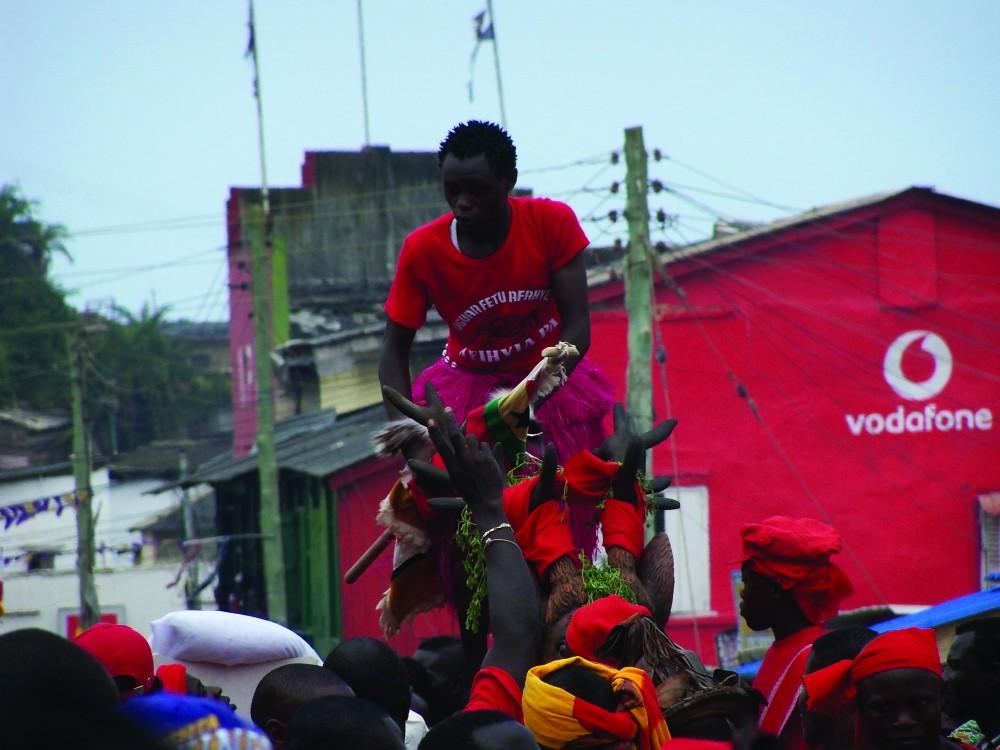Professor uses photography from Ghana research trip in Red Wall Gallery exhibit

Courtesy Photo / Amy Masko English professor Amy Masko during her journey to Ghana.
Aug 29, 2012
This fall, the Red Wall Gallery at Grand Valley State University’s Allendale Campus will play host to the work of professor Amy Masko, depicting her research and teachings in Cape Coast, Ghana.
“The Asafo of Ghana: A Life History of an Asafo Flag Dancer” is Masko’s photographic journey of a young Frankaakitsanyi, or flag dancer.
An assistant professor of English at GVSU, Masko was awarded the Fulbright Fellowship in 2009, which allowed her and her family to spend eight months in Ghana while she taught at the University of Cape Coast.
Though Masko went to Ghana laregely with the intention of studying the educational system there, the project began unexpectedly after she began to interview some of the native Oguaa people, who spoke about spirituality.
“You can only see this, and understand this in real drumming,” Masko said the Ghanaians told her, and she knew she had to become part of an actual culture group.
Nana Otu, a high school-aged flag dancer then invited her to be a part of his Asafo. The gallery photos follow the story of Otu, one of three dancers in the Asafo No. 1 Company that Masko photographed.
While the Asafo companies perform at funerals and festivals, many of the photos Masko took were during the Fetu-Afahye festival – a celebration of harvest and happiness.
Despite their history of competitiveness during these festivals, she never felt threatened while spending time with the Asafo No. 1 Company, she said.
“It’s definitely friendly, ritualistic fun,” Masko said. “Everyone there has a feeling of fun.”
The seven Asafos in Cape Coast are former militia groups from the colonial era of Ghana, but they are now focused more on spiritual and ritualistic aspects. Their festivals include blessing the lagoon in hopes of bountiful fishing and parading through the streets, pounding drums and singing in progression.
Masko compares the Asafo to a Boy Scouts group. She said it is good for young men in Ghana, teaching them morals and training them to be good people.
Several of the gallery’s photos depict just that, showing Otu teaching Masko a song, which she said translates to, “if you get something, let’s all eat. If a problem comes, we will all solve it together.”
Masko said that because of other obligations, many younger people do not have time to be part of the movements, and elder citizens fear that they are losing interest in the traditions.
Between living and cooking with Out and his family and marching in a parade alongside the Asafo, Masko said the research trip was an eye-opening experience and that she felt a great sense of honor among the Oguaa people and plans on keeping in touch with Otu and the Asafo.
With help from Sherry Johnson, program director of African/African American studies and assistant professor of English at GVSU, Masko is trying to set up a study abroad program to Ghana, tentatively set for June 2013.
Until GVSU students can experience the dancing for themselves, however, they can still imagine it through Masko’s photographs.
The gallery runs through Sept. 19 and is free and open to the public.
For more information about the photos or Masko’s journey, contact the Art Gallery at 616-331-2563.

























